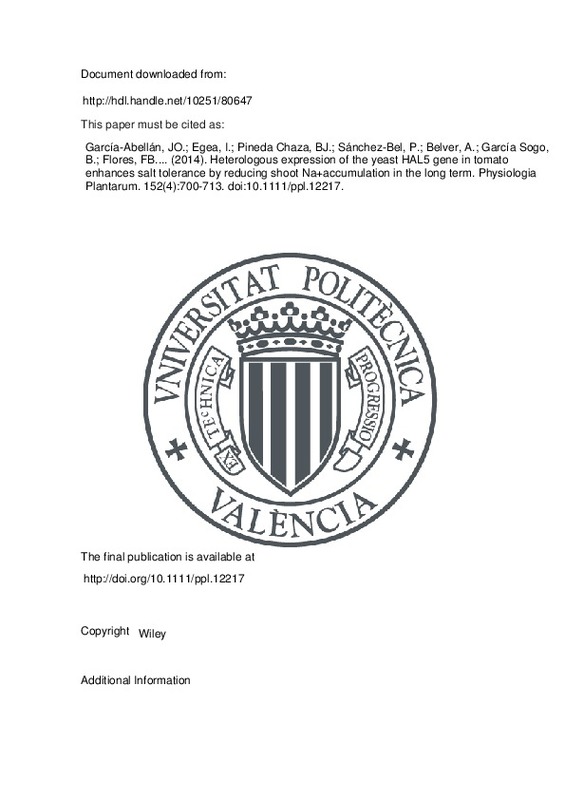JavaScript is disabled for your browser. Some features of this site may not work without it.
Buscar en RiuNet
Listar
Mi cuenta
Estadísticas
Ayuda RiuNet
Admin. UPV
Heterologous expression of the yeast HAL5 gene in tomato enhances salt tolerance by reducing shoot Na+accumulation in the long term
Mostrar el registro sencillo del ítem
Ficheros en el ítem
| dc.contributor.author | García-Abellán, José O.
|
es_ES |
| dc.contributor.author | Egea, Isabel
|
es_ES |
| dc.contributor.author | Pineda Chaza, Benito José
|
es_ES |
| dc.contributor.author | Sánchez-Bel, Paloma
|
es_ES |
| dc.contributor.author | Belver, Andrés
|
es_ES |
| dc.contributor.author | García Sogo, Begoña
|
es_ES |
| dc.contributor.author | Flores, Francisco B.
|
es_ES |
| dc.contributor.author | Atarés Huerta, Alejandro
|
es_ES |
| dc.contributor.author | Moreno Ferrero, Vicente
|
es_ES |
| dc.contributor.author | Bolarín, Maria C.
|
es_ES |
| dc.date.accessioned | 2017-05-05T09:10:31Z | |
| dc.date.available | 2017-05-05T09:10:31Z | |
| dc.date.issued | 2014-12 | |
| dc.identifier.issn | 0031-9317 | |
| dc.identifier.uri | http://hdl.handle.net/10251/80647 | |
| dc.description.abstract | [EN] For salt tolerance to be achieved in the long-term plants must regulate Na+/K+ homeostasis over time. In this study, we show that the salt tolerance induced by overexpression of the yeast HAL5 gene in tomato (Solanum lycopersicum) was related to a lower leaf Na+ accumulation in the long term, by reducing Na+ transport from root to shoot over time regardless of the severity of salt stress. Furthermore, maintaining Na+/K+ homeostasis over time was associated with changes in the transcript levels of the Na+ and K+ transporters such as SlHKT1;2 and SlHAK5. The expression of SlHKT1;2 was upregulated in response to salinity in roots of transgenic plants but downregulated in the roots of wild-type (WT) plants, which seems to be related to the lower Na+ transport rate from root to shoot in transgenic plants. The expression of the SlHAK5 increased in roots and leaves of both WT and transgenic plants under salinity. However, this increase was much higher in the leaves of transgenic plants than in those of WT plants, which may be associated with the ability of transgenic leaves to maintain Na+/K+ homeostasis over time. Taken together, the results show that the salt tolerance mechanism induced by HAL5 overexpression in tomato is related to the appropriate regulation of ion transport from root to shoot and maintenance of the leaf Na+/K+ homeostasis through modulation of SlHKT1 and SlHAK5 over time. | es_ES |
| dc.description.sponsorship | This work was funded by grant AGL2012-40150-C03 from the Spanish 'Ministerio de Economia y Competitividad' and grant 04553/GERM/06 from the Fundacion SENECA, Murcia (Spain). I. E. and B. P. were supported by a postdoctoral position from the JAE-Doc program of National Research Council (CSIC). We thank Prof. R Serrano (IBMCP-CSCIC, Valencia, Spain) for providing the plasmid vector. We thank Stephen Hasler for his help in editing the English version of the manuscript. | |
| dc.language | Inglés | es_ES |
| dc.publisher | Wiley | es_ES |
| dc.relation.ispartof | Physiologia Plantarum | es_ES |
| dc.rights | Reserva de todos los derechos | es_ES |
| dc.subject | High-affinity potassium | es_ES |
| dc.subject | Salinity tolerance | es_ES |
| dc.subject | Plasma membrane | es_ES |
| dc.subject | Transgenic tomato | es_ES |
| dc.subject | HKT transporters | es_ES |
| dc.subject | Stress tolerance | es_ES |
| dc.subject | Sodium transport | es_ES |
| dc.subject | Antiporter sos1 | es_ES |
| dc.subject | Plants | es_ES |
| dc.subject | K+ | es_ES |
| dc.subject.classification | GENETICA | es_ES |
| dc.title | Heterologous expression of the yeast HAL5 gene in tomato enhances salt tolerance by reducing shoot Na+accumulation in the long term | es_ES |
| dc.type | Artículo | es_ES |
| dc.identifier.doi | 10.1111/ppl.12217 | |
| dc.relation.projectID | info:eu-repo/grantAgreement/MINECO//AGL2012-40150-C03-03/ES/IDENTIFICACION, ETIQUETADO Y ANALISIS FUNCIONAL DE GENES IMPLICADOS EN EL CUAJADO DEL FRUTO DE TOMATE Y TOLERANCIA A LA SALINIDAD EN ESPECIES SILVESTRES RELACIONADAS/ | es_ES |
| dc.relation.projectID | info:eu-repo/grantAgreement/MINECO//AGL2012-40150-C03-01/ES/IDENTIFICACION, ETIQUETADO Y ANALISIS FUNCIONAL DE GENES IMPLICADOS EN EL CUAJADO DEL FRUTO DE TOMATE Y TOLERANCIA A LA SALINIDAD EN ESPECIES SILVESTRES RELACIONADAS/ | es_ES |
| dc.relation.projectID | info:eu-repo/grantAgreement/f SéNeCa/Funding Program for Research Groups of Excellence/04553%2FGERM%2F06/ | es_ES |
| dc.relation.projectID | info:eu-repo/grantAgreement/MINECO//AGL2012-40150-C03-02/ES/IDENTIFICACION, ETIQUETADO Y ANALISIS FUNCIONAL DE GENES IMPLICADOS EN EL CUAJADO DEL FRUTO DE TOMATE Y TOLERANCIA A LA SALINIDAD EN ESPECIES SILVESTRES RELACIONADAS/ | es_ES |
| dc.rights.accessRights | Abierto | es_ES |
| dc.contributor.affiliation | Universitat Politècnica de València. Instituto Universitario Mixto de Biología Molecular y Celular de Plantas - Institut Universitari Mixt de Biologia Molecular i Cel·lular de Plantes | es_ES |
| dc.contributor.affiliation | Universitat Politècnica de València. Escuela Técnica Superior de Ingeniería Agronómica y del Medio Natural - Escola Tècnica Superior d'Enginyeria Agronòmica i del Medi Natural | es_ES |
| dc.description.bibliographicCitation | García-Abellán, JO.; Egea, I.; Pineda Chaza, BJ.; Sánchez-Bel, P.; Belver, A.; García Sogo, B.; Flores, FB.... (2014). Heterologous expression of the yeast HAL5 gene in tomato enhances salt tolerance by reducing shoot Na+accumulation in the long term. Physiologia Plantarum. 152(4):700-713. https://doi.org/10.1111/ppl.12217 | es_ES |
| dc.description.accrualMethod | S | es_ES |
| dc.relation.publisherversion | http://doi.org/10.1111/ppl.12217 | es_ES |
| dc.description.upvformatpinicio | 700 | es_ES |
| dc.description.upvformatpfin | 713 | es_ES |
| dc.type.version | info:eu-repo/semantics/publishedVersion | es_ES |
| dc.description.volume | 152 | es_ES |
| dc.description.issue | 4 | es_ES |
| dc.relation.senia | 277382 | es_ES |
| dc.identifier.eissn | 1399-3054 | |
| dc.identifier.pmid | 24773242 | |
| dc.contributor.funder | Ministerio de Economía y Competitividad | |
| dc.contributor.funder | Fundación Séneca-Agencia de Ciencia y Tecnología de la Región de Murcia |







![[Cerrado]](/themes/UPV/images/candado.png)

